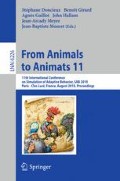Abstract
We present two models of the behaviour of the hawkmoth Manduca sexta when it approaches an artificial flower with an olfactory, visual or multimodal cue. The first model treats each condition separately while the second model combines both types of sensory cues in a single model. Both models reproduce several characteristic properties of the hawkmoth behaviour including its goal direction and velocity profile for different stimulus types. In addition, the second model accounts for the interaction between visual and olfactory cues.
Access this chapter
Tax calculation will be finalised at checkout
Purchases are for personal use only
Preview
Unable to display preview. Download preview PDF.
References
Andersson, S., Dobson, H.E.: Behavioral foraging responses by the butterfly eliconius melpomene to Lantana camara floral scent. J. Chem. Ecol. 29, 2302–2318 (2003)
Balkenius, A., Rosén, W., Kelber, A.: The relative importance of olfaction and vision in a diurnal and a nocturnal hawkmoth. J. Comp. Physiol. A 192(4), 431–437 (2006)
Stein, B., Stanford, T.: Multisensory integration: current issues from the perspective of the single neuron. Nature Reviews Neuroscience 9(4), 255–266 (2008)
Balkenius, A., Kelber, A.: Colour preferences influences odour learning in the hawkmoth, Macroglossum stellatarum. Naturwissenschaften 93(5), 255–258 (2006)
Balkenius, A., Bisch-Knaden, S., Hansson, B.: Interaction of visual and odour cues in the mushroom body of the hawkmoth manduca sexta. J. Exp. Biol. 212, 535–541 (2009)
Braitenberg, V.: Vehicles. MIT Press, Cambridge (1984)
Biró, Z., Ziemke, T.: Evolution of visually-guided approach behavior in recurrent artificial neural network robot controllers. In: Pfeifer, R., Blumberg, B., Meyer, J. (eds.) From animals to animats 5: proceedings of the Fifth International Conference on Simulation of Adaptive Behavior, pp. 73–77. MIT Press, Cambridge (1998)
Grasso, F., Consi, T., Mountain, D., Atema, J.: Locating odor sources in turbulence with a lobster inspired robot. In: Maes, P., Matarik, M., Meyer, J.A., Pollack, J., Wilson, S.W. (eds.) From Animals to Animats 4, vol. 4, pp. 104–112. MIT Press, Cambridge (1996)
Webb, B.: Robots, crickets and ants: models of neural control of chemotaxis and phonotaxis. Neural Networks 11(7-8), 1479–1496 (1998)
Webb, B.: Spiking neuron controllers for a sound localising robot. Dynamical Systems, Wave-Based Computation and Neuro-Inspired Robots, 119–130 (2008)
Balkenius, A., Dacke, M.: Flight behaviour of the hawkmoth manduca sexta toward unimodal and multimodal targets. (submitted, 2010)
Ljung, L.: System Identification: Theory for the User, 2nd edn. Prentice Hall PTR, Englewood Cliffs (1998)
Raguso, R., Pichersky, E.: A day in the life of a linalool molecule: chemical communicaion in a plant-pollinator system. Plant Species Biol. 14, 95–120 (1999)
Stauffer, C., Grimson, W.E.L.: Adaptive background mixture models for real-time tracking. In: Proceedings of 1999 IEEE Computer Society Conference on Computer Vision and Pattern Recognition, Fort Colins, CO, vol. 2 (1999)
Duda, R.O., Hart, P.E., Stork, D.G.: Pattern Classification. Wiley-Interscience Publication, Hoboken (2000)
Cootes, T.F., Taylor, C.J., Cooper, D.H., Graham, J.: Active shape models—their training and application. Comput. Vis. Image Underst. 61(1), 38–59 (1995)
Balkenius, A., Kelber, A., Balkenius, C.: Simulations of learning and behaviour in the hawkmoth deilephila elpenor. In: ICSAB: Proceedings of the Seventh International Conference on Simulation of Adaptive Behavior on From Animals to Animats, pp. 85–92. MIT Press, Cambridge (2002)
Author information
Authors and Affiliations
Editor information
Editors and Affiliations
Rights and permissions
Copyright information
© 2010 Springer-Verlag Berlin Heidelberg
About this paper
Cite this paper
Balkenius, A., Dacke, M., Balkenius, C. (2010). The Approach Behaviour of the Hawkmoth Manduca sexta toward Multi-modal Stimuli: A Simulation Model. In: Doncieux, S., Girard, B., Guillot, A., Hallam, J., Meyer, JA., Mouret, JB. (eds) From Animals to Animats 11. SAB 2010. Lecture Notes in Computer Science(), vol 6226. Springer, Berlin, Heidelberg. https://doi.org/10.1007/978-3-642-15193-4_22
Download citation
DOI: https://doi.org/10.1007/978-3-642-15193-4_22
Publisher Name: Springer, Berlin, Heidelberg
Print ISBN: 978-3-642-15192-7
Online ISBN: 978-3-642-15193-4
eBook Packages: Computer ScienceComputer Science (R0)

